INFINITI Q50 HYBRID 2018 First responder´s Guide
Manufacturer: INFINITI, Model Year: 2018, Model line: Q50 HYBRID, Model: INFINITI Q50 HYBRID 2018Pages: 44, PDF Size: 5.23 MB
Page 31 of 44
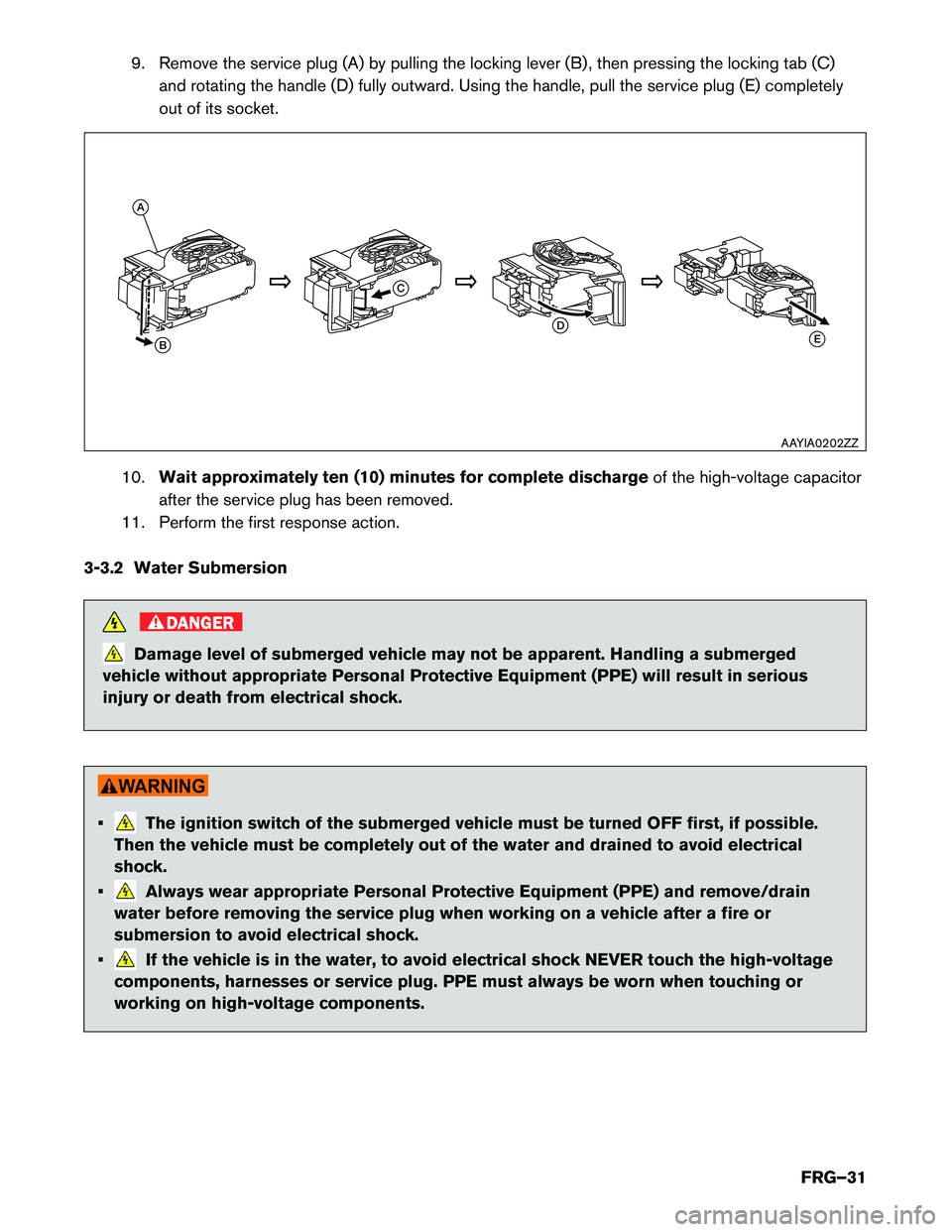
9. Remove the service plug (A) by pulling the locking lever (B) , then pressing the locking tab (C)
and rotating the handle (D) fully outward. Using the handle, pull the service plug (E) completely
out of its socket.
10. Wait approximately ten (10) minutes for complete discharge of the high-voltage capacitor
after the service plug has been removed.
11. Perform the first response action.
3-3.2 Water Submersion DANGER
Damage level of submerged vehicle may not be apparent. Handling a submerged
vehicle
without appropriate Personal Protective Equipment (PPE) will result in serious
injury or death from electrical shock. • The ignition switch of the submerged vehicle must be turned OFF first, if possible.
Then
the vehicle must be completely out of the water and drained to avoid electrical
shock.
• Always wear appropriate Personal Protective Equipment (PPE) and remove/drain
water
before removing the service plug when working on a vehicle after a fire or
submersion to avoid electrical shock.
• If the vehicle is in the water, to avoid electrical shock NEVER touch the high-voltage
components,
harnesses or service plug. PPE must always be worn when touching or
working on high-voltage components. A
B C
D
E
AAYIA0202ZZ
FRG–31
Page 32 of 44
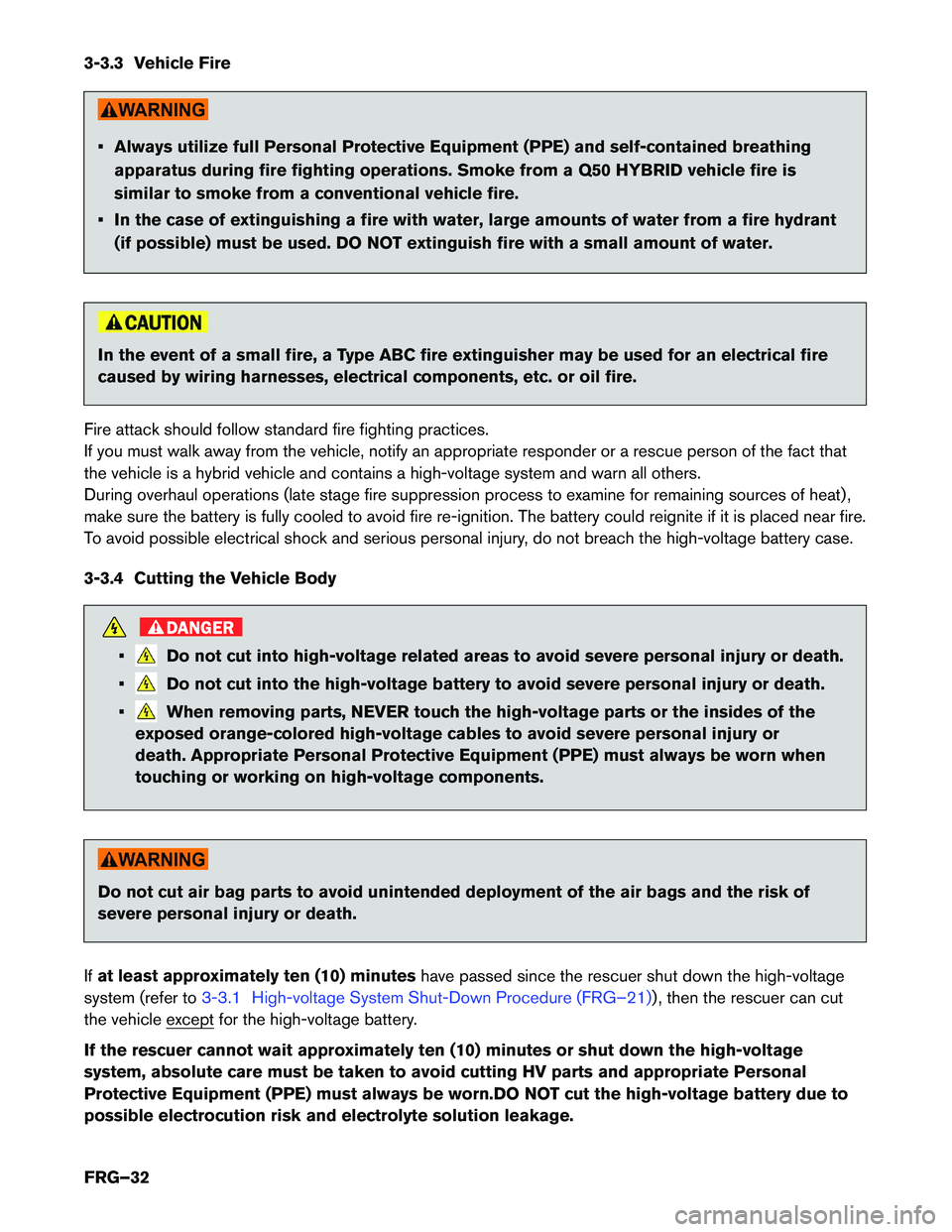
3-3.3 Vehicle Fire
• Always utilize full Personal Protective Equipment (PPE) and self-contained breathing
apparatus during fire fighting operations. Smoke from a Q50 HYBRID vehicle fire is
similar to smoke from a conventional vehicle fire.
• In the case of extinguishing a fire with water, large amounts of water from a fire hydrant (if possible) must be used. DO NOT extinguish fire with a small amount of water. In the event of a small fire, a Type ABC fire extinguisher may be used for an electrical fire
caused
by wiring harnesses, electrical components, etc. or oil fire.
Fire attack should follow standard fire fighting practices.
If you must walk away from the vehicle, notify an appropriate responder or a rescue person of the fact that
the vehicle is a hybrid vehicle and contains a high-voltage system and warn all others.
During overhaul operations (late stage fire suppression process to examine for remaining sources of heat) ,
make sure the battery is fully cooled to avoid fire re-ignition. The battery could reignite if it is placed near fire.
To avoid possible electrical shock and serious personal injury, do not breach the high-voltage battery case.
3-3.4 Cutting the Vehicle Body DANGER
• Do not cut into high-voltage related areas to avoid severe personal injury or death.
• Do not cut into the high-voltage battery to avoid severe personal injury or death.
• When removing parts, NEVER touch the high-voltage parts or the insides of the
exposed
orange-colored high-voltage cables to avoid severe personal injury or
death. Appropriate Personal Protective Equipment (PPE) must always be worn when
touching or working on high-voltage components. Do not cut air bag parts to avoid unintended deployment of the air bags and the risk of
severe
personal injury or death.
If at least approximately ten (10) minutes have passed since the rescuer shut down the high-voltage
system (refer to 3-3.1 High-voltage System Shut-Down Procedure (FRG–21)) , then the rescuer can cut
the
vehicle except for the high-voltage battery. If the rescuer cannot wait approximately ten (10) minutes or shut down the high-voltage
system,
absolute care must be taken to avoid cutting HV parts and appropriate Personal
Protective Equipment (PPE) must always be worn.DO NOT cut the high-voltage battery due to
possible electrocution risk and electrolyte solution leakage.
FRG–32
Page 33 of 44

SRS Air Bag System Components Location
Avoid
cutting air bag system parts. However, the vehicle can be cut (except inflators) under the following
conditions: • The front, side and curtain air bags have deployed.
• At least three (3) minutes have passed after the 12-volt battery negative (-) cable has beendisconnected and the high-voltage system has been shut down. = Inflators
(Peel
back plastic trim parts prior to cutting operation to confirm exact inflator location.) = Sensors
AAYIA0188ZZ
FRG–33
Page 34 of 44

1. Crash zone sensor (located
underhood
near hood latch) 2. Supplemental front air bag
modules (Infiniti Advanced Air
Bags) 3. Front seat-mounted side-
impact supplemental air bags
4. Roof-mounted curtain side-
impact supplemental air bags 5. Roof-mounted curtain side-
impact supplemental air bag
inflators6. C-pillar satellite sensors
(LH shown, RH similar)
7. Seat belt buckle pretensioners 8. Seat belts with pretensioners 9. B-pillar satellite sensors
10. Air bag control unit (ACU) 11. Front door satellite sensors (LH shown, RH similar) 21
10 4 53
8 7 6
9
11
AAYIA0189ZZ
FRG–34
Page 35 of 44
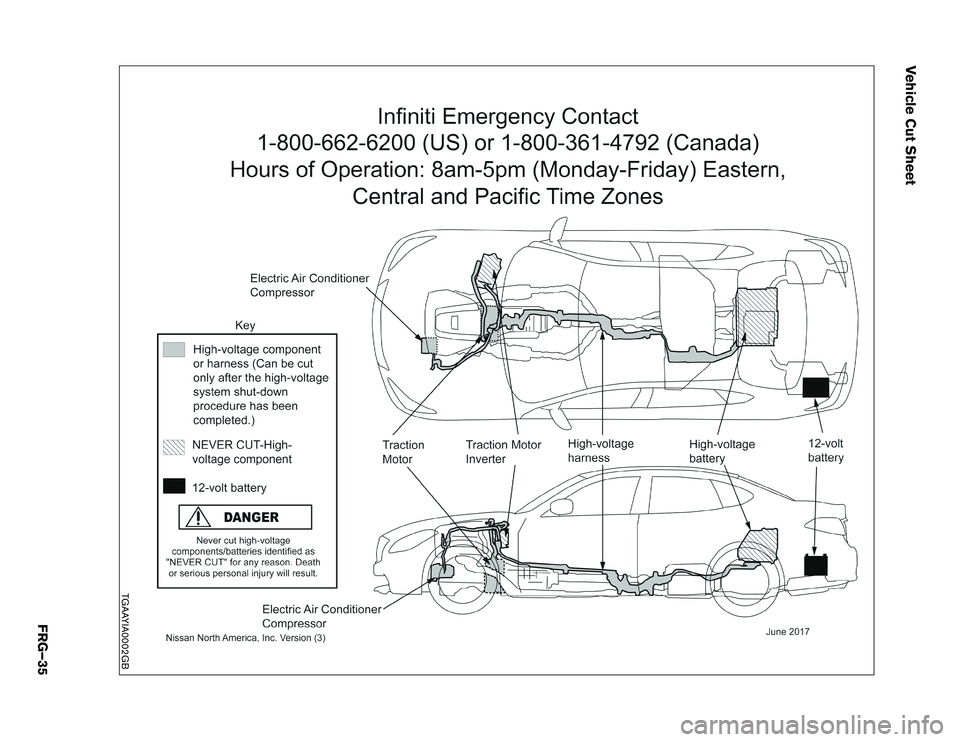
Vehicle Cut Sheet
TGAAYIA0002GB
FRG–35
Page 36 of 44

High Strength Steel Locations
= High strength steel
=
3-3.5 High-voltage Battery Damage And Fluid Leaks
The high-voltage battery contains electrolyte solution. To avoid exposure to electrolyte
solution
and serious personal injury, always wear appropriate solvent resistant Personal
Protective Equipment (PPE) and read the following precautions:
• Electrolyte solution is a skin irritant.
• Electrolyte solution is an eye irritant – If contact with eyes, rinse with plenty of water and see a doctor immediately.
• If electrolyte leak occurs, wear appropriate solvent resistant PPE and use a dry cloth to clean up the spilled electrolyte. Be sure to adequately ventilate the area.
• Electrolyte solution is highly flammable.
• Electrolyte liquid or fumes that have come into contact with water vapors in the air will create an oxidized substance. This substance may irritate skin and eyes. In these cases,
rinse with plenty of water and see a doctor immediately.
• Electrolyte fumes (when inhaled) can cause respiratory irritation and acute intoxication. Move to fresh air and wash mouth with water. See a doctor immediately. AAYIA0190ZZ
FRG–36
Page 37 of 44

If electrolyte solution leakage, or damage such as any problem with the high-voltage battery casing are
observed,
first responders should attempt to neutralize the battery by applying a large volume of water to the
battery pack while wearing appropriate Personal Protective Equipment (PPE) . The neutralization process
helps stabilize the thermal condition of the battery pack but does not discharge the battery.
High-voltage Battery Electrolyte Solution Characteristics: • Clear in color
• Sweet odor
• Similar viscosity to water
• Since the high-voltage battery is made up of many small sealed battery modules, electrolyte solutionleakage should be minimal.
NOTE:
Other fluids in the vehicle (such as engine oil, washer fluid, brake fluid, coolant, etc.) are
the same as those in a conventional vehicle.
3-3.6 Accessing the Occupants 1. Remove windowsa. Perform window removal the same as a normal vehicle.
2. Remove doors a. The doors are removable with hand tools or basic rescue tools such as electrical/hydraulicrescue tools. It may be easier to remove the doors by cutting door hinges.
NOTE:
Before disconnecting the 12-volt battery terminal, if necessary, lower the
windows, adjust the steering column, adjust the seats, unlock the doors, etc.
Once 12-volt battery is disconnected, power controls will not operate.
3. Adjust steering wheel and front seat position (if necessary) as shown below: AAYIA0197ZZ
FRG–37
Page 38 of 44
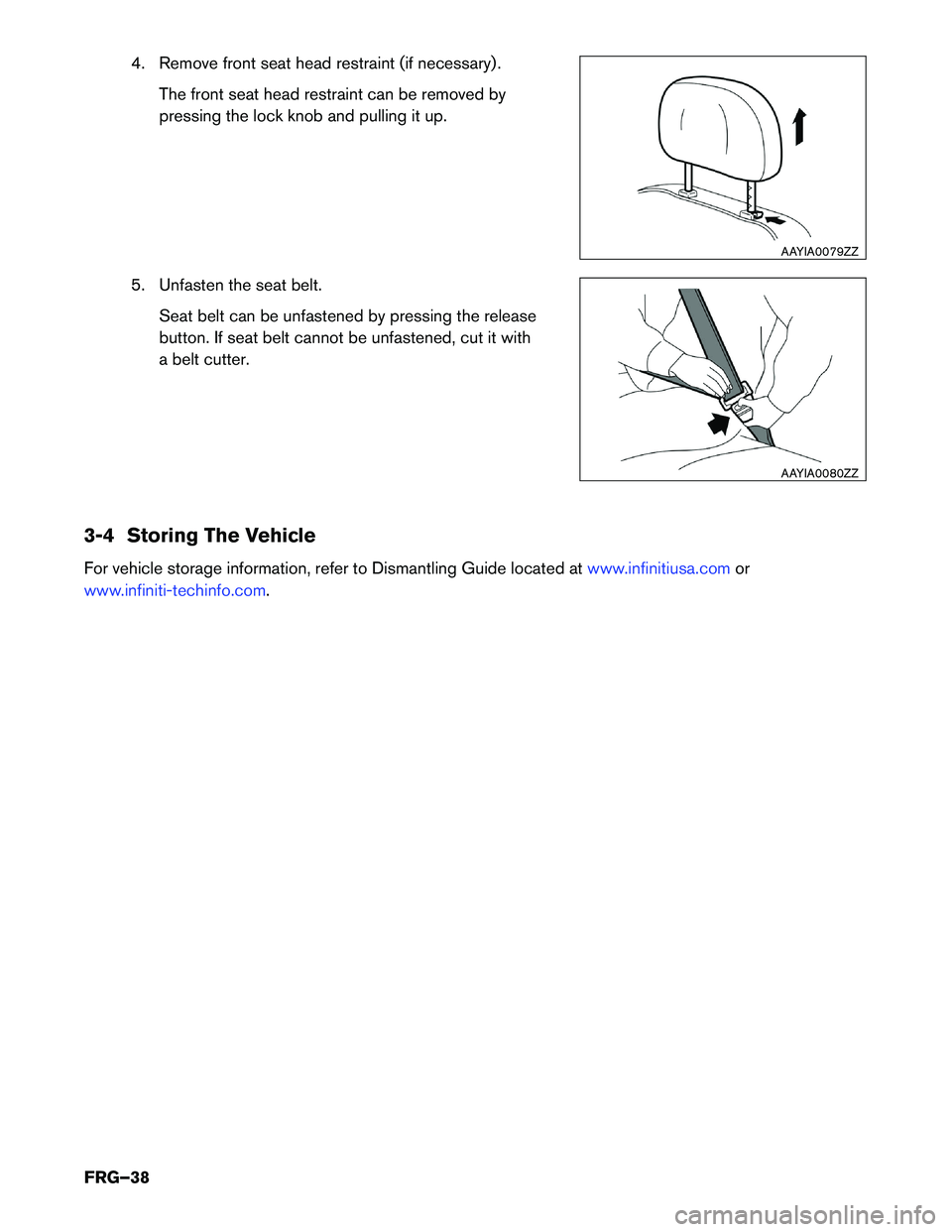
4. Remove front seat head restraint (if necessary) .
The front seat head restraint can be removed by
pressing the lock knob and pulling it up.
5. Unfasten the seat belt. Seat belt can be unfastened by pressing the release
button. If seat belt cannot be unfastened, cut it with
a belt cutter.
3-4 Storing The Vehicle
For vehicle storage information, refer to Dismantling Guide located at www.infinitiusa.comor
www.infiniti-techinfo.com. AAYIA0079ZZ
AAYIA0080ZZ
FRG–38
Page 39 of 44
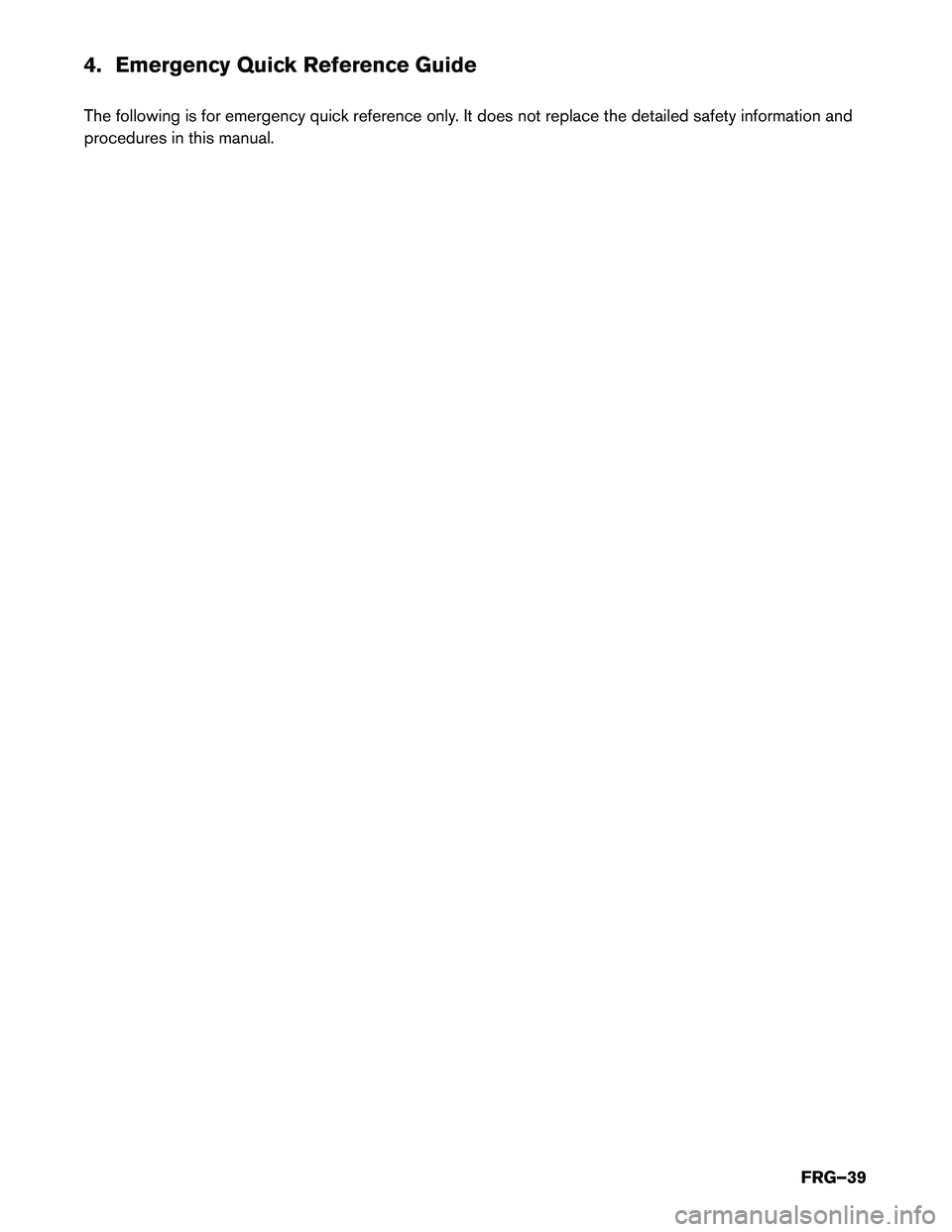
4. Emergency Quick Reference Guide
The
following is for emergency quick reference only. It does not replace the detailed safety information and
procedures in this manual.
FRG–39
Page 40 of 44
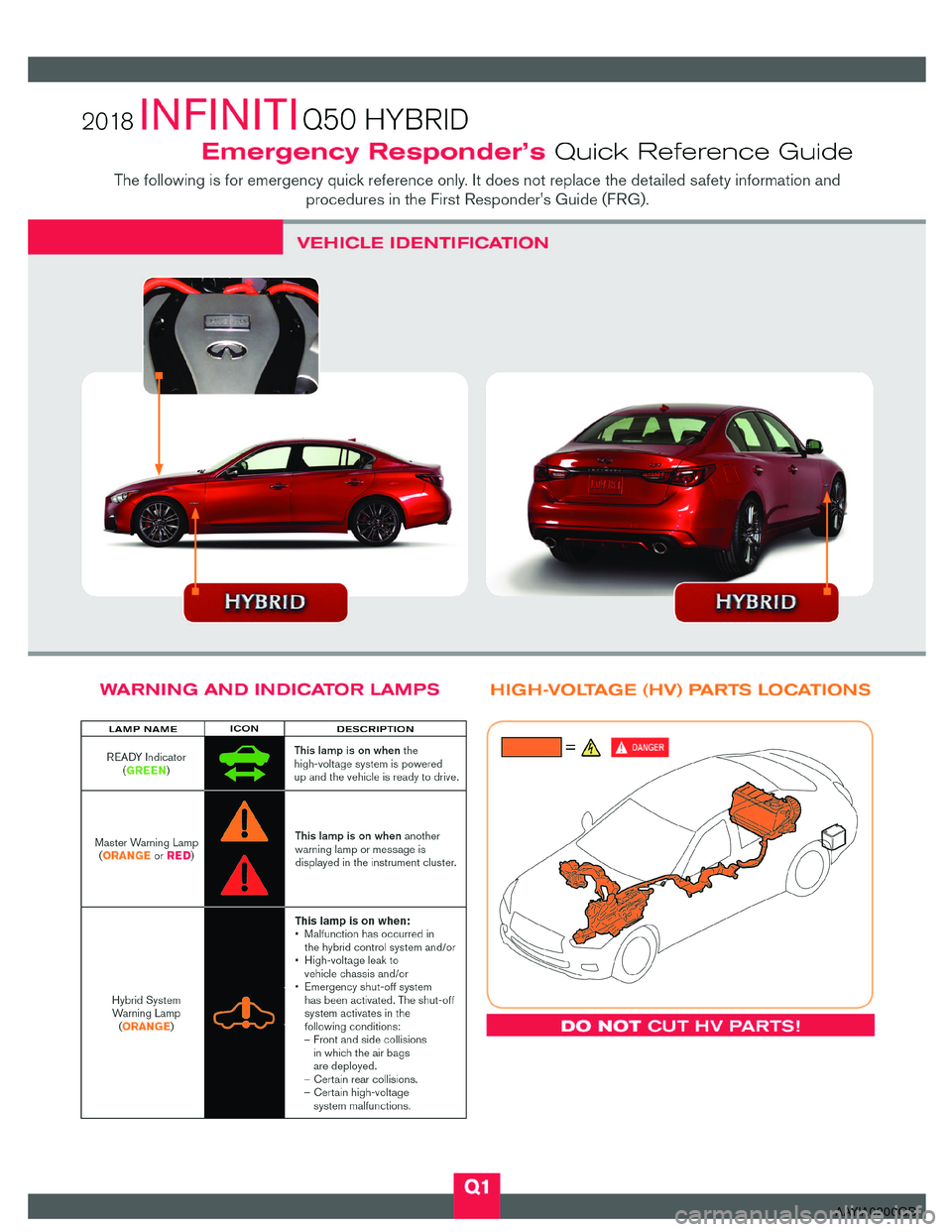
AAYIA0200GB